First noted around 1974, the Mulberry Variety notes have a random inking flaw producing variably dark serial numbers, which in some cases appear almost black, in place of normally bright red numbers. The darker the ink of the mulberry, the more sought-after the note. They are about as scarce as replacement notes, with the ‘black’ ones being quite rare. The mulberry variety notes are regarded as a major variety amongst Irish banknotes.
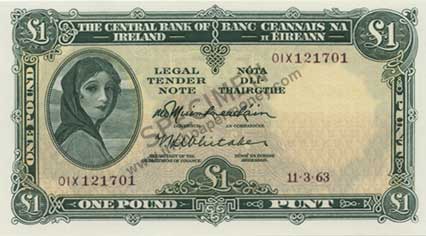
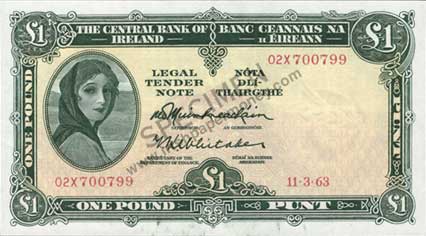
Above, a mulberry variety £1 note, with 01X prefix, and a normal red shade numbered £1 note with 02X prefix illustrates the difference in appearance of the mulberry notes.
One of the more interesting variations among Irish government-issued banknotes is the ‘mulberry’ serial variety which was first noted in the 1970s on certain banknotes of the Legal Tender Note (LTN) denominations. The term ‘mulberry’ is attributed to David Keable, one of the major UK dealers of the 1970s and 1980s who first used it to describe the unusually dark shade of the serial numbers that appears on some of the red-numbered banknotes in the period 1959-1963 (the ‘later’ mulberry notes).
All the dates for which these mulberry variety banknotes exist are listed below. Most examples of each of these dates have normal red serial numbers. Mulberry serial numbers have also occasionally been seen on earlier notes (the ‘earlier’ mulberry notes), most notably on some Consolidated ‘Ploughman’ Bank Notes dated in the 1930s. Red numbered denominations are £1, £5, £10, £50, and £100 notes. 10 Shilling notes and £20 notes have black serial numbers and are not affected by the variety.
The later mulberry variety first appears on Type 9 notes (McElligott, Whitaker signature combination), on a small quantity of £1 notes dated 2.9.59, after Thomas De La Rue Ltd. (TDLR) took over printing of the denomination from Waterlow and Sons Ltd. All of the affected denominations presented with the mulberry variety after TDLR began to print them. No Waterlow notes of this period have been seen as the mulberry variety, and the variety disappears entirely after the date ranges listed below.
Listed are the range of dates which exist with mulberry serial numbers, starting when De La Rue took over the printing of the Irish Legal Tender Notes, commencing with £1 notes dated 2.9.59. A small percentage (approximately 0.6%) of the banknotes of these dates have been seen with mulberry serial numbers of some degree. Most notes of these dates have normal red serial numbers. £1 notes dated 2.9.59 and 16.3.62 have a higher instance of slight mulberry (M1, M2) than the other dates listed.
Type 9. 1956-1960. McElligott, Whitaker signatures
£1 Notes: 2.9.59, 18.5.60.
Type 11. 1961-1968. Muimhneacháin, Whitaker signatures
£1 Notes: 16.3.62, 11.3.63, 3.4.63;
£5 Notes: 15.8.61, 30.5.62, 20.6.63;
£10 Notes: 2.5.62, 17.5.62, 29.5.62;
£50 Notes: 1.2.62;
£100 Notes: 16.1.63.
Note: There are also occasional isolated instances of mulberry serial numbers on earlier banknotes throughout the Legal Tender Note and Consolidated Bank Note series. No instances of Mulberry serials have ever been seen subsequent to the dates listed above.
Very minor variations in the shades of the red-numbered notes exist throughout the A Series banknotes. These are not to be confused with the Mulberry variety. Given the variable nature of the phenomenon, a descriptive scale of how ‘mulberry’ a mulberry note is can be a matter of opinion.
The darkest, so-called ‘black mulberries’ are, however, quite strikingly dark, though still definitely deep red as revealed by a close up examination. The range of shades of Mulberry numerals is classified on a scale of M-2 to M5, the number indicating the relative darkness. M0 corresponds to the normal shade of red used for numbering the notes; M-1 corresponds to a paler than normal red, which verges on being pink, with M-2 corresponding to a bright pink shade; M5 corresponds to a red so dark as to appear almost black. M3 corresponds to the deep mulberry red after which this variation is labelled. It is probable that all of the dates occurred as the full range of M0 to M5. Only a few £1 and £5 notes have been seen with the lighter M-1, M-2 shades.
Most mulberry notes are a dark shade of blood-red, M3, with many of them displaying a mottled variation in red colour throughout the ink of the serial numbers on a given banknote. A few notes have been recorded with lighter pink serial numbers (<1% of all mulberries, M-2), and rather more with very dark numbers (~5% of all mulberries, M5). The very dark ‘black’ mulberry’ notes are those most sought-after, especially in nice grade.
Variations
The variable nature of the ink gives rise to some highly interesting variations. Mulberry serial numbers have been seen on runs of £1 notes in sequence, especially those dated 11.3.63, for which a lot of notes in sequence have been kept as all notes of this date went into circulation in 1974.
A run of £10 notes (dated 17.5.62) with several mulberry notes amongst them, and a run of £5 notes (dated 20.6.63) of normal red serial numbers with one mulberry note in the sequence have also been recorded, illustrated below. Runs of notes in sequence have been seen showing an increase in darkness from normal red to dark ‘black’ mulberry over the course of a few notes.
Sharp variations occur also on single banknotes, with ranges of mulberry ink within a single serial number. One of the most interesting mulberry banknotes yet seen is a £5 note dated 15.8.61, 79W 913182, illustrated, an asymmetric mulberry note, which is ‘black’ mulberry on the right hand side, and normal red on the left. This presents the collector with a very attractive and interesting item.
What causes the mulberry shade?
There has never been a satisfactory or official explanation for the cause of the mulberry variety. The Issuing Authority appears not to have regarded it as an error, as there is no indication of the notes having been withdrawn. Also, Specimen notes exist with and without the mulberry ink shades.
The mulberry colour may simply be due to excessive amounts of ink being applied, overinking, producing the darker effect, though ink bleed around the digits of the date and serial numbers is not noticeably greater than on normal non-mulberry notes of the same dates. The darker ‘black’ mulberry notes sometimes show significant soaking of the ink into the paper so that it shows on the reverse of the banknote, an indication of overinking.
However, no instances of offsetting of the ink from other notes on the reverse of any mulberry notes has been seen, so drying of the ink does not seem to have been a problem. The paler pink shades (M-1, M-2) could similarly be due to slight underinking.
Many collectors of Irish notes are likely to want to add a nice example of a mulberry note of £1, £5, and £10 denominations to their collection, with a normal note of each of the same date. An example of a mulberry M3 £1 note in VF grade is relatively easily obtained.
Those seeking their mulberry in UNC grade should be able to come across an example of a £1 note dated 11.3.63 with at least M3 serial numbers, a nice deep red. Collectors looking for examples of the other denominations, and for the rarer black (M5) mulberries will likely have to compromise a bit on grade, as none have been seen in UNC.
Good EF to AU grade are the best examples of mulberry notes other than £1 notes dated 11.3.63 that have been recorded in the Lavery Rare Notes Census. A nice dark (M3) late mulberry LTN can carry a premium of at least double the value of an ordinary note of the same date in any given grade. Higher grade examples (EF or better), and ‘black’ mulberry notes can fetch more.
Slight mulberry notes (M1-M2) tend not to bring much, if any premium.
£50 notes dated 1.2.62 and £100 dated 16.1.63 notes are quite scarce notes generally. Mulberry examples of these notes are far scarcer than those of the lower denominations, due mainly to much lower printing volumes, although there are a few £100 notes recorded as very dark mulberry, some of them in nice EF grade. Very few mulberry £50 notes have been seen. Collectors would be very challenged to obtain a decent example of a mulberry of either if the denominations.
‘Black’ mulberry serial numbers have been seen on some Consolidated ‘Ploughman” Bank Notes (CBN), generally on banknotes dated 1936-39, and most notably on £1 notes of the Hibernian, National, Munster & Leinster, Provincial, and Ulster banks.
The ‘black’ mulberry Ploughman notes are a very attractive variation of the banknotes. As with the LTN, a run of £1 notes of the Munster & Leinster Bank has been recorded which includes normal shade red and dark mulberry serial numbers occurring on successive banknotes.
Varying degrees of mostly minor mulberry serials (M2-M3) have also been seen on some later £1 and £5 notes of all the banks. Ploughman notes in general are quite costly, and there is currently no price premium for the mulberry notes amongst them.
Slightly mulberry serial numbers (M3) have been seen on some early LTN Lavery notes, the most significant being on £5, 10.9.28, T/01 090004, a nice AU grade note, and a nice variation on a scarce first date note. T/04 009005 has also been seen—it has normal red serial numbers.
There is a scattering of slightly mulberry (M1-M3) serial numbers throughout the LTN series. The serial numbers are not dark enough to be noteworthy, and the quantities of notes seen are far less than those of the later mulberry group in the 1959-63 era.
£1 notes dated 2.9.59 and 18.5.60. Design 2.
£1 notes dated 11.3.63. 01X and 02X prefix Extraordinary Issue. Issued in 1974.
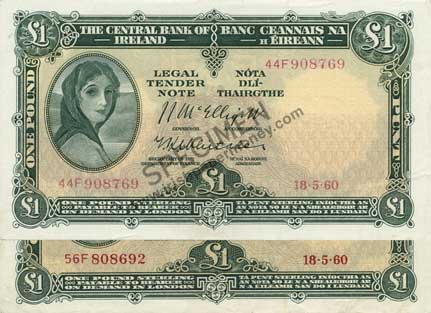
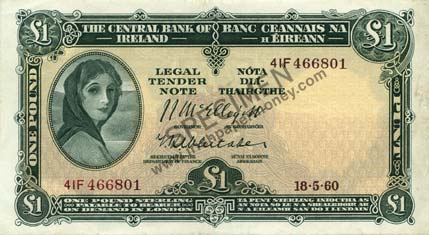
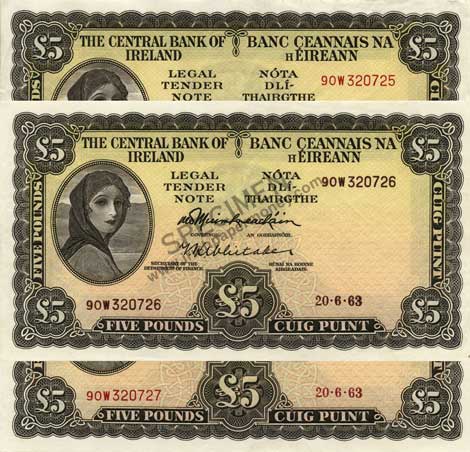
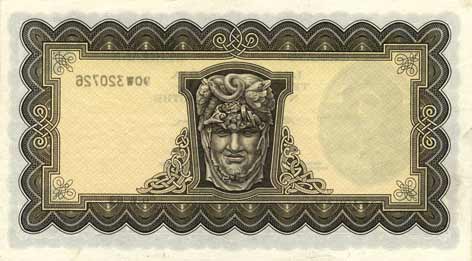
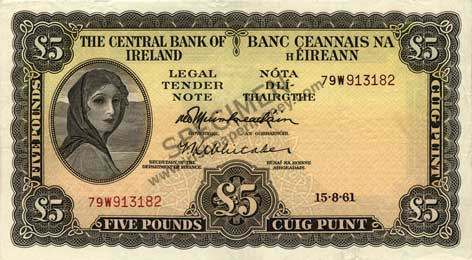
The above Five Pound note is one of the most interesting mulberry variety notes yet seen. It demonstrates the degree of variance in the ink deposition that can happen even on a single note.

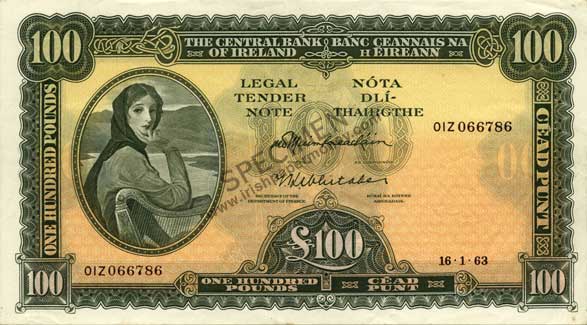
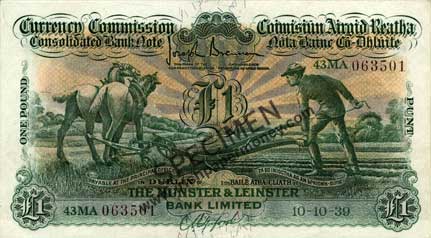
Special Sections and Articles
The Transition of Irish Currency, Irish banknotes 1918–1928
The Partition of Irish Currency, Irish banknotes 1928–1930
Banknote Design Evolution 1824 to 1916
Irish Three Pound Notes
Contemporary Forgeries of Early Irish Banknotes, ca1800-1930
Limerick Soviet Notes
Irish World War 2 Banknote Issues
Low Number Irish Banknotes
Irish Joint Stock Banks of Note Issue from 1783
Irish Legal Tender Note Specimens
Ploughman Scan Survey (PSS)
1 Pound Ploughman
5 Pounds Ploughman
10 Pounds Ploughman
20 Pounds Ploughman
50 Pounds Ploughman
100 Pounds Ploughman
Irish Ten Shilling Notes
1 Pound Note Lady Lavery
5 Pounds Lady Lavery
10 Pounds Lady Lavery
20 Pounds Lady Lavery
50 Pounds Lady Lavery
100 Pounds Lady Lavery
1 Pound Note, Queen Medb
5 Pound Note, John Scotus Eriugena
10 Pound Note, Jonathan Swift
20 Pound Note, W. B. Yeats
50 Pound Note, Turlough O'Carolan
100 Pound Note, Grace O'Malley
5 Pound Note, Sister Catherine McAuley
10 Pound Note, James Joyce
20 Pound Note, Daniel O'Connell
50 Pound Note, Douglas Hyde
100 Pound Note, Charles Stewart Parnell
Northen Ireland Polymer notes
Bank of Ireland Polymer Notes
Danske Bank Polymer Notes
Ulster Bank Polymer Notes